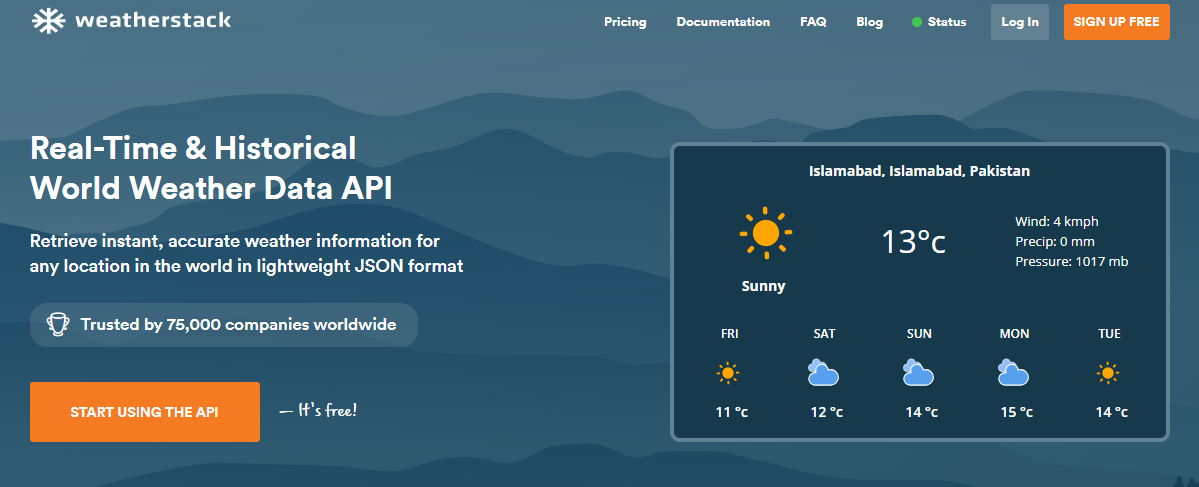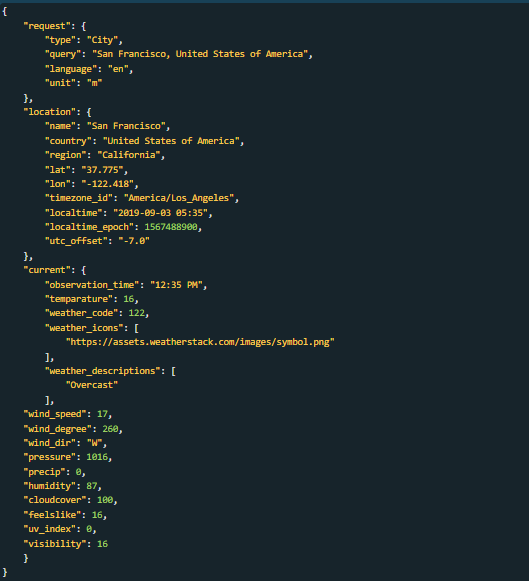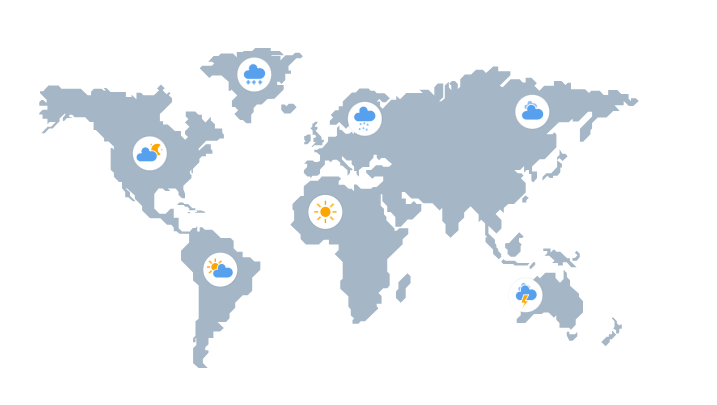Disasters can hit us in any form – floods, earthquakes, hurricanes, tsunamis, or droughts. And they have far-reaching impacts, affecting individuals, businesses, and governments. For individuals, disasters can lead to injuries, displacement and homelessness, psychological trauma, and even loss of life. For businesses, disasters can disrupt operations, such as supply chains, and cause physical damage to infrastructure, buildings, and equipment, leading to huge financial losses and reputational damage. At the government level, disasters can severely affect the economy and damage infrastructure, such as houses, roads, bridges, public facilities, etc.
While we cannot avoid disasters altogether, we can surely prepare for them to reduce their impact. Especially with increasing climate change and environmental degradation, disaster management and preparedness have become the need of the hour for individuals, businesses, and governments alike. This is where a disaster management weather API can play a crucial role. For instance, a reliable weather API provides accurate weather forecast data, alerting us about disasters like floods and hurricanes in a timely manner.
This article will provide a thorough understanding of weather APIs and disaster management and explore the role of a weather API in disaster management and preparedness.
 A weather API is basically an application programming interface that provides us with real-time weather information and weather forecasts. Some reliable APIs like weatherstack also provide years of historical weather data, enabling us to understand weather trends and patterns. Essentially, we can use a weather API to integrate weather data (real-time, historical, or future) into our apps, websites, or systems. This way, we don’t have to gather accurate weather data from various sources and compile it. These APIs do all this time-consuming and challenging work for us.
Reliable weather APIs gather data from various dependable sources, such as:
A weather API is basically an application programming interface that provides us with real-time weather information and weather forecasts. Some reliable APIs like weatherstack also provide years of historical weather data, enabling us to understand weather trends and patterns. Essentially, we can use a weather API to integrate weather data (real-time, historical, or future) into our apps, websites, or systems. This way, we don’t have to gather accurate weather data from various sources and compile it. These APIs do all this time-consuming and challenging work for us.
Reliable weather APIs gather data from various dependable sources, such as:
 Weatherstack is a leading weather API offering highly accurate real-time, historical and weather forecast data. The API is trusted by over 75,000 companies worldwide, including Microsoft Ericsson, Schneider, and Deloitte, for its data accuracy, scalability, efficiency, and easy integration.
Here are the main features of the weatherstack API:
Weatherstack is a leading weather API offering highly accurate real-time, historical and weather forecast data. The API is trusted by over 75,000 companies worldwide, including Microsoft Ericsson, Schneider, and Deloitte, for its data accuracy, scalability, efficiency, and easy integration.
Here are the main features of the weatherstack API:
 Here is an example response from weatherstack weather API for weather forecast data:
Here is an example response from weatherstack weather API for weather forecast data:
 Also read: Weatherstack API: A Solution for Efficient Energy Management.
Also read: Weatherstack API: A Solution for Efficient Energy Management.
Table of Contents
Understanding Weather APIs
- Large weather stations covering millions of locations worldwide
- National Weather Service (NWS)
- Satellites, and radars
- Global and local weather models
- Location (country, city, region, latitude, and longitude)
- Time (local time and timezone)
- Current weather information (wind speed, wind degree, wind direction, pressure, precipitation, humidity, cloud cover, feels like, UV index, and visibility)
- Historical weather data
- Weather forecast (minimum temperature, maximum temperature, average temperature, total snow, sun hour, heat index, chance of rain, chance of remaining dry, chance of windy, chance of overcast, chance of sunshine, and more).
What is Disaster Management?
Disasters can be natural, such as hurricanes, earthquakes, floods, tsunamis, and extreme temperatures, or manmade, such as industrial accidents, pollution, etc. While manmade disasters can be avoided, natural disasters are not in our control. However, they can disrupt business operations, communities, lives, and economics. For instance, in 2022, heavy rains flooded the Brazilian town of Petropolis, destroying lives and homes. In the same year, the Philippines was hit by Tropical Storm Megi, leading to tragic results. Fortunately, with disaster management and preparedness, we can lessen the impact of disasters, saving lives and costs and ensuring continuity of operations. Disaster management is essentially the process of preparing for disasters in advance and responding to them effectively. It enables organizations, governments, and communities to tackle disasters efficiently. It involves organizing and managing resources strategically to minimize the severity of disasters. Moreover, managing disaster preparedness, response, and recovery responsibilities are also part of disaster management. For individuals, disaster management involves personal preparedness. This can include securing homes and stocking up on groceries and essential supplies. For businesses, disaster management involves safeguarding assets, creating plans for maintaining continuity of operations, and ensuring the welfare of employees. At the governmental level, disaster management includes comprehensive planning, organization and coordination of resources and effective response mechanisms to protect citizens and infrastructure.The Role of Weather APIs in Disaster Management and Preparedness
Weather APIs play a crucial role in disaster management and preparedness. Here are various ways how they can help:Timely Alerts and Notifications
Weather APIs provide weather forecast data, allowing us to know about future weather conditions. We can use this information to assess the possibility of disasters in the near future and create disaster response plans accordingly. A weather API can be integrated into weather apps or communication systems to receive timely alerts and notifications regarding extreme weather conditions in the coming days.Anticipating Disaster Events
Weather APIs that offer accurate historical data can be used for predictive modelling. Historical weather data allows us to understand weather trends and patterns and predict future weather conditions. Thus, we can use this data to anticipate and prepare for potential disasters. For example, Organizations can analyze past weather trends and patterns to identify locations more susceptible to disaster, enabling them to develop targeted preparedness and mitigation strategies.Disaster Response Plans
Weather APIs can be used to integrate accurate real-time and weather forecast data into disaster response plans. Emergency responders can use weather information to make informed and effective decisions about evacuation routes, resource allocation, shelter locations, and deployment of personnel during disaster events.Risk Assessment and Vulnerability Analysis
Weather APIs provide organizations and governments with risk assessment weather data. For example, organizations and governments can use historical and weather forecast data to conduct risk assessments and vulnerability analyses and identify areas susceptible to hazards. This approach, driven by accurate data, helps allocate resources effectively, create effective mitigation strategies, and reduce the impact of disasters.Planning and Resource Allocation
Governments and businesses can use a weather API to get accurate weather forecasts for planning and resource allocation decisions. For example, government agencies and businesses can adjust staffing and stockpile supplies based on forecasted weather conditions to respond to potential disasters effectively.Training and Simulation Exercises
Governments and businesses can leverage weather API-driven scenarios for training and simulation exercises for emergency responders and disaster management teams. They can test the effectiveness of their response plans, identify gaps, and improve their strategies accordingly.Challenges and Limitations of Weather APIs
While weather APIs can significantly help with disaster management and preparedness, not all APIs are made equal. Here are the key challenges and limitations of weather APIs:Accuracy Concerns
The accuracy of a weather API depends on data sources and data processing algorithms. Since different APIs have different data sources and coverage, not all weather APIs provide highly accurate data. Inaccurate weather data can significantly affect disaster management and preparedness strategies, resulting in additional costs, wastage of time and resources, and even loss of lives. Fortunately, today, we have cutting-edge technology that allows us to measure weather conditions with high precision. Reliable weather APIs gather data from various sources, including trustworthy weather stations, satellites, radars, and forecast models.Integration Issues
Seamless integration of weather API into an app or system is essential to get timely information for disaster management. However, not all weather APIs integrate smoothly, causing issues with fetching accurate weather data. Moreover, some APIs don’t have proper documentation, making the integration process time-consuming and challenging.Response Time
Some weather APIs can take so long to return data, impacting the accuracy of real-time data and user experience. Factors such as network congestion, server load, and data processing times can affect the responsiveness of the API.Introducing Weatherstack: A Reliable Weather API for Current, Historical and Future Weather Data
 Weatherstack is a leading weather API offering highly accurate real-time, historical and weather forecast data. The API is trusted by over 75,000 companies worldwide, including Microsoft Ericsson, Schneider, and Deloitte, for its data accuracy, scalability, efficiency, and easy integration.
Here are the main features of the weatherstack API:
Weatherstack is a leading weather API offering highly accurate real-time, historical and weather forecast data. The API is trusted by over 75,000 companies worldwide, including Microsoft Ericsson, Schneider, and Deloitte, for its data accuracy, scalability, efficiency, and easy integration.
Here are the main features of the weatherstack API:
- The API is powered by rock-solid and reliable data sources, offering the highest level of reliability, consistency and accuracy.
- The high-performance API has a lightning-fast response time. It delivers data in an easy-to-read JSON format within milliseconds and has an uptime of nearly 100%.
- Weatherstack REST API is backed by robust and highly scalable cloud infrastructure, capable of handling billions of requests per day.
- The API covers millions of locations worldwide, providing accurate global weather data.
- Weatherstack provides accurate real-time weather data for any location of your choice. You simply need to attach your desired location to the ‘current’ endpoint, and the API will instantly return the data.
| https://api.weatherstack.com/current ? access_key = YOUR_ACCESS_KEY & query = New York |
- The API provides detailed weather data, which includes location information (country, city, region, latitude, and longitude), time (local time and timezone), and current weather information (wind speed, wind degree, wind direction, pressure, precipitation, humidity, cloud cover, feels like, UV index, and visibility)
- The API supports historical data all the way back to 2008.
- Weatherstack also provides highly accurate weather forecast data for up to 14 days into the future. It also supports hourly data, or you can define 3,6,12, or 24-hour intervals, depending on the subscription plan.
- The weatherstack API allows you to make bulk requests for multiple locations simultaneously, saving time and effort.
- Weatherstack has extensive documentation consisting of all the details about API endpoints and parameters. The documentation also provides various coding examples to ease the integration process.
 Here is an example response from weatherstack weather API for weather forecast data:
Here is an example response from weatherstack weather API for weather forecast data:
 Also read: Weatherstack API: A Solution for Efficient Energy Management.
Also read: Weatherstack API: A Solution for Efficient Energy Management.
Conclusion
Weather APIs play a crucial role in disaster management and preparedness by providing highly accurate current, historical, and weather forecast data. Here are various ways these APIs can help:- Enable timely alerts and notifications
- Provide historical and future weather data to anticipate disaster events
- Help formulate effective disaster response plans
- Facilitate risk assessment and vulnerability analysis using historical weather data
- Help with planning and resource allocation based on weather forecasts
- Facilitate training and simulation exercises based on weather API-driven scenarios

